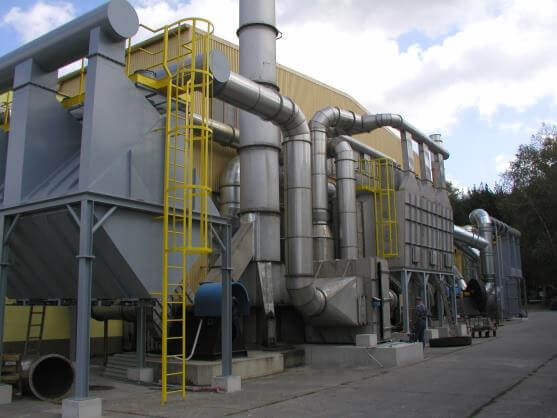Separation of solid pollutants
Introduction:
For separation of solid pollutants are used especially wet mechanical separators, which achieve higher separation effeciency for fine particles than dry mechanical separators. This technology is suitable for adhesive and abrasive particles, higher inlet concentrations, dust with explosion risk, etc.
In most cases the separation of solid pollutants is at the same time combined with separation of gaseous pollutants.
Among the wet mechanical separators can be included spray separators, separators with trickle floating internals, apparatus with Venturi nozzle and foam-layer absorber.
List of references:
Farmak a.s., Olomouc (chemical-pharmaceutical industry), Czech republic
- Design, delivery and commissioning of the separator of solid pollutants and droplet separator.
- 2.200 – 7.500 m3/h
- Year of realization: 2002
PAVUS, a.s., Veselí nad Lužnicí, Czech republic
- Design, delivery, assembly and commissioning of the line for waste gas cleaning (Contaminants: solid pollutants, acidic components and TOC – benzoate) produced during fire resistance testing of construction products.
- 30.000 Nm3/h (flue gas temperature max. 100°C)
- 20.000 Nm3/h (flue gas temperature max. 300°C)
- Year of realization: 2009
E-therm TZ s.r.o., Klatovy, Poland
- Design and delivery of the line for waste gas cleaning (Contaminants: solid pollutants, acidic components and TOC – benzoate) produced during fire resistance testing of construction products.
- 18.000 Nm3/h (flue gas temperature max. 100°C)
- 10.000 Nm3/h (flue gas temperature max. 300°C)
- Year of realization: 2014
Vítkovice Gearworks Ostrava (heating plant), Turkey
- Design and delivery of the technological device for separation of exhausted vapor and solid pollutants – filter of waste vapours for oprational set of ash management.
- 800-1.900 m3/h
- 650-1.150 m3/h
- Year of realization: 2014

